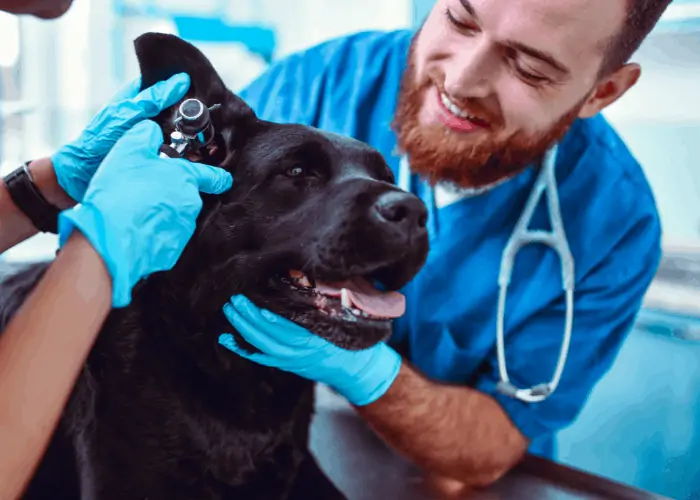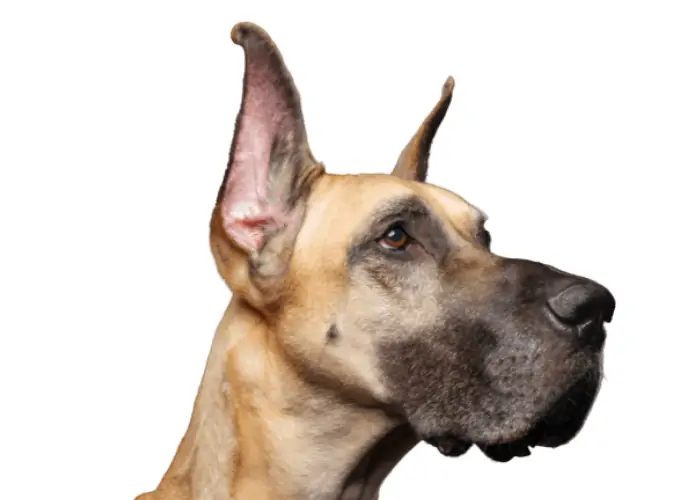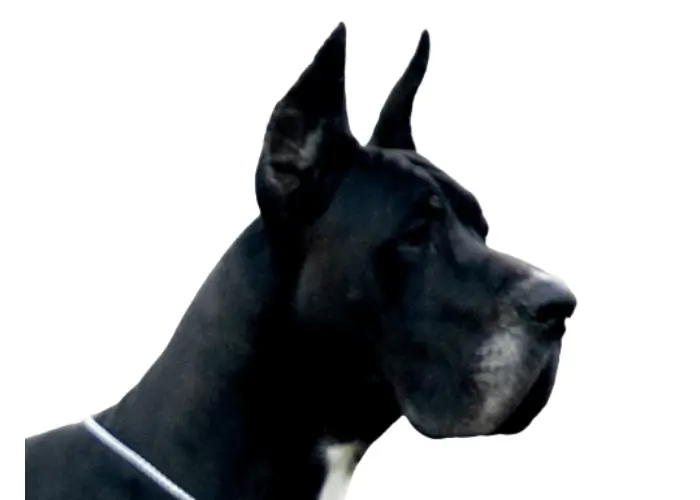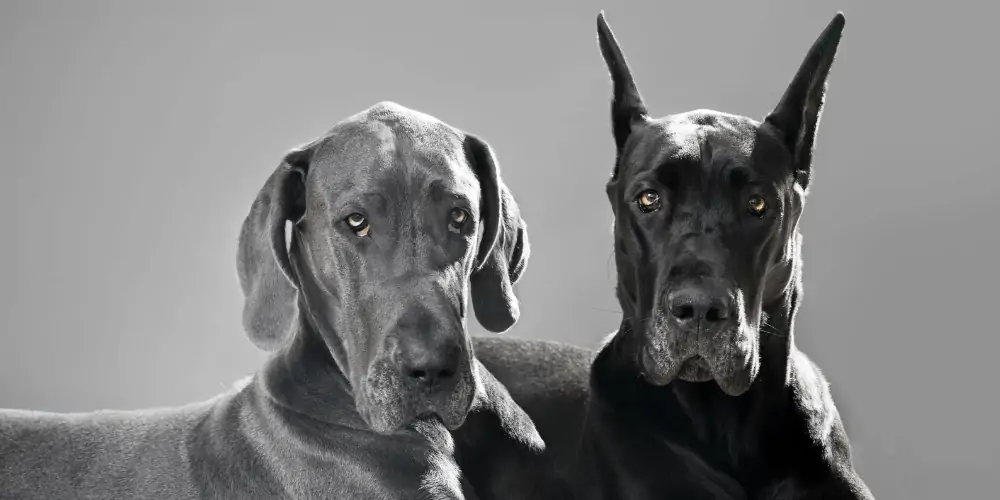When you think of Great Danes, you probably think about their large athletic bodies and narrow, pointy, upright ears. To get this look, Great Danes must undergo ear-cropping surgery.
Below is vital information about Great Dane ear cropping, its history, how it’s done, and what after-surgery care is needed for your puppy. Also included is information about different crop styles and different wrapping methods.
What is Great Dane Ear Cropping?
Great Dane ear cropping involves cutting the externally visible flap of the dog’s ear (also called the pinna) to get the desired long and pointy shape. The cut ears are repeatedly taped and wrapped to make the ears stand up. The dog’s ear heals, taking on the desired upright and narrow appearance.
Ear cropping is also often done on breeds like Pit bulls, Dobermans, Schnauzers, Boxers, and Cane Corsos.
Tail docking and ear cropping are two surgical procedures commonly performed on many dog breeds. These procedures are classified as medically unnecessary surgeries whose purpose is primarily cosmetic.
–US National Library of Medicine National Institutes of Health
History of Great Dane Ear Cropping

Great Dane ear cropping dates back over three hundred years.
Since Great Danes were often used for hunting wild boar in Europe, dog owners cropped their ears to prevent injury.
Boars are dangerous creatures with sharp teeth and tusks. Historically, these teeth and tusks would cause injuries to the floppy ears of the Great Danes.
Because of this, owners began cropping their Great Danes’ ears. They believed that the pointy ears would be less prone to injury by the dangerous boars.
Others believed that cropped ears could prevent health problems like ear infections.
Ear cropping remains an option for Great Dane owners today. Although cropped ears are easier to clean than naturally floppy ears, ear cropping is primarily a cosmetic procedure.
Data suggests that about 130,000 puppies undergo ear cropping in the United States annually.
Ear Cropping Surgery

The surgery to crop Great Danes’ ears is relatively inexpensive.
Most owners pay around $500 to have cropping done by a qualified veterinarian.
The price varies depending on the location and skill of the veterinarian. Great Dane owners should be wary of offers to crop ears for $100 or less.
Because this is a medical procedure for your puppy, the utmost care and skill should be used.
A Great Dane puppy should have its ears cropped between 7 and 10 weeks old.
It may be too late if a puppy is over 12 weeks of age. At this stage in the puppy’s development, cartilage has developed. Waiting too long to crop a puppy’s ear may result in twisted or disfigured ears.
When a puppy has its ears cropped, general anesthesia is used. The veterinarian carefully removes more than half of the puppy’s ear from the externally visible flap on the ear and stitches sew the incisions closed.
The Great Dane’s ear is then taped with a medical dressing or held with foam or glue. After 8 to 10 days, the veterinarian will remove your puppy’s stitches and rigidly tape the ears upright.
To ensure proper healing, owners must clean, tape, and re-tape ears for six months to a year. Over this time, the Great Dane’s ears will heal into the upright shape created by the cropping procedure.
Failure to properly care for your dog’s ears can lead to bent, twisted, or disfigured ears. Great Dane owners must be ready to provide regular care for six months or longer.
After Surgery Care

If you move forward with ear cropping for your Great Dane, you should take the following actions to provide after-surgery care to your puppy:
- Follow the veterinarian’s directions and guidelines precisely as they’re given. Deviating from veterinarian instructions can lead to disfigured ears, infection, or illness.
- Change your puppy’s dressings as recommended by your veterinarian. Be careful to administer any medications as prescribed.
- Make sure to carefully and regularly clean your puppy’s ears after surgery.
- Please do not allow your puppy to scratch or bite its cropped ears. Because this procedure causes discomfort, your puppy may be inclined to scratch its ears.
- Regularly clean the cut or incision on your puppy’s cropped ears. Use ear wash peroxide or another disinfectant as recommended by your veterinarian.
- If scabs form on your puppy’s incisions, hold a warm washcloth on the ears for about five minutes. The warm water will soften the clotted blood and help remove scabs that develop on your puppy’s incisions. Ensure bandages do not get wet during cleaning, as wet dressings may cause infection.
- After washing your puppy’s cropped ears, use antibiotic cream on the incision. Ask your veterinarian how often to apply antibiotic cream to prevent infections.
- Watch for any signs of infections in your puppy’s ears. Talk to your veterinarian immediately if you notice swelling, redness, or any other unusual appearance. An infection of your Great Dane’s incisions can cause serious harm to your puppy.
Your veterinarian may give you additional guidelines. Above all, follow their instructions to properly heal your Great Dane’s cropped ears.
Taping and Posting Your Great Dane’s Cropped Ears

There are a few different ways to tape and post your Great Dane’s ears after a cropping surgery.
The most common method is the tampon or post method; another option is ear taping with pipe foam.
1. Tampon or Post Method
The tampon or post method uses a tampon or similarly shaped piece of cardboard to act as a post. This post supports your dog’s ear after cropping.
Use a post and bandages to wrap your Great Dane’s ears. You should remove the dressings and posts once a week and allow your dog’s ears to breathe slightly.
Inspect the ears for signs of infection, clean them, and allow them to dry. Once dry, you can re-wrap your puppy’s ears with a new post and fresh bandages.
You will need to re-wrap your dog’s ears every week for six to twelve months until your Great Dane’s ears stand up on their own.
If you wrap it too tightly, you may cause harm to your dog. When changing the wrapping, call your veterinarian if you find any signs of infection.
2. Pipe Foam Method
A shaped piece of pipe foam is used for the pipe foam method instead of a post. Cut the pipe foam into the shape of your puppy’s ear, from bell to tip. The cut foam should match the lines you want for your dog’s cropped ear shape.
After cleaning your puppy’s ears and allowing them to dry, place the foam against the ear entirely.
Be careful to make sure it lines up with the edges of your dog’s ears. Wrap bandage tape until the tape and foam are securely in place.
Don’t wrap your Great Dane’s ears too tightly, as this can cause problems. If your puppy scratches the wrapping, you may use medical adhesive instead.
Consult your veterinarian about wrapping your puppy’s ears after ear cropping surgery.
Popular Great Dane Cropping Styles
There are different styles of cropping available for your Great Dane. Below is some information about the different crop types.
Show Crop ( Long and Medium )

A show crop gives your Great Dane a longer, taller ear look.
Because this type of ear cropping is so narrow, it runs a great risk of not standing when healed.
To ensure they stand up successfully, you must regularly wrap and post your Great Dane’s ears after the cropping surgery.
A show crop can be either long or medium, although most Great Danes in the United States dog shows are large dogs with cropped ears. The long, pointy ears often associated with Great Danes result from a long show crop.
Pet Crop

The pet crop, a.k.a. working crop/military crop, provides a nice and clean appearance for your Great Dane.
The ears are cut with a short, broad base and a triangular shape. This cropped look is more common and easier to maintain, and it takes less taping and posting to make the ears stand on their own.
Ethical Questions about Great Dane Ear Cropping
Some pet owners have raised concerns about whether or not ear cropping and tail docking are ethical.
Because there is no significant, modern medical reason for cropping ears, it is considered purely cosmetic surgery.
Veterinarians are divided on the issue. Some will refuse to do the procedure out of concern for the dog’s well-being.
Ear cropping is illegal in Australia, Canada, and many European countries.
If ear infections are a concern, talk to your veterinarian about ear cropping and alternative treatments.
In most cases, changes in diet and hygiene practices can help prevent ear infections. There is little statistical evidence that ear cropping prevents infections in Great Danes.
Conclusion

Great Dane ear cropping has a long and rich history.
Today, many pet owners get their Great Dane’s ears cropped to achieve a desired aesthetic.
Great Danes with cropped ears often look stronger and more athletic.
Despite concerns over the ethics of getting a dog’s ears cropped, ear cropping remains a common practice in the United States and worldwide.
REFERENCES:
1. Welfare implications of ear cropping-dogs. American Veterinary Medical Association. (n.d.). Retrieved February 3, 2023, from https://www.avma.org/resources-tools/literature-reviews/welfare-implications-ear-cropping-dogs
2. Mills, K. E., Robbins, J., & von Keyserlingk, M. A. G. (2016, June 27). Tail docking and ear cropping dogs: Public awareness and perceptions. PloS one. Retrieved February 3, 2023, from https://www.ncbi.nlm.nih.gov/pmc/articles/PMC4922641



